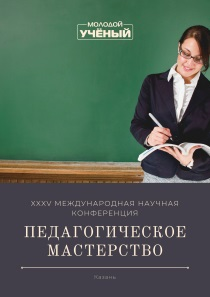Faith and superstition of Catholics and Orthodox (on the example of the Astrakhan region)
Авторы: Величко Елена Владленовна, Акатова Эльвира Равильевна
Рубрика: 5. Педагогика общеобразовательной школы
Опубликовано в
XXXV международная научная конференция «Педагогическое мастерство» (Казань, октябрь 2022)
Дата публикации: 29.09.2022
Статья просмотрена: 1 раз
Библиографическое описание:
Величко, Е. В. Faith and superstition of Catholics and Orthodox (on the example of the Astrakhan region) / Е. В. Величко, Э. Р. Акатова. — Текст : непосредственный // Педагогическое мастерство : материалы XXXV Междунар. науч. конф. (г. Казань, октябрь 2022 г.). — Казань : Молодой ученый, 2022. — С. 23-29. — URL: https://moluch.ru/conf/ped/archive/461/17445/ (дата обращения: 24.04.2024).
In the light of the current conflict situation between Russia and Ukraine, relations between believers of the Catholic and Orthodox churches, who profess a single religion — Christianity, have become rather sharply aggravated. Astrakhan is a multinational city. Three world religions crossed here: Christianity, Islam and Buddhism. Moreover, there are different currents of Christianity: Orthodoxy, Catholicism, Protestantism, the Apostolic Church.
The Christian faith was divided into Catholicism and Orthodoxy almost a thousand years ago, and the differences still exist [5; p. 7]. Are they significant? We decided to find out if they are not separating individual residents of the region.
The purpose of the study : comparison of Orthodoxy and Catholicism in the Astrakhan region.
To achieve this purpose, it was necessary to solve the following tasks: Проанализировать литературу по данной теме;
- Analyze the literature on the topic;
- Interview priests representing Catholicism and Orthodoxy;
- Consider some traditions and rituals of the two religions.
The research hypothesis is that peoples professing Orthodoxy and Catholicism have much in common.
The study began with a survey in which 40 students from grades 7 and 8 took part. The children were asked to answer the following questions:
- What is your religion? (Orthodox, Catholic, don't know)
- Do you often go to church with your parents? (Not really)
- Would you like to know more about Orthodox holidays: Easter, Christmas? (Well no)
- Would you like to visit Catholic and Orthodox churches? (Well no)
- Do you welcome European religious holidays (Christmas-December 25, St. Valentine's Day, etc.).
As a result of the survey, it was found that among 40 Christian students, only two attend the Orthodox Church, but all 40 people welcome holidays and rituals belonging to Catholics.
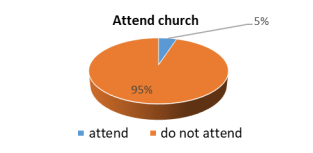
Fig. 1
In the course of the study, the Catholic and Orthodox churches of our city were visited and interviews were conducted with the clergy (Father Konstantin — the Assumption Cathedral on the territory of the Kremlin and Father Waldemar — the Catholic Church — Babushkina, 81). As a result of interviews with the clergy, we found out that in our topic, the architectural differences of temples come to the fore:
- There is no iconostasis in the Catholic church;
- In a Catholic church, the throne is located in front of the parishioners (in the Orthodox church, the throne is turned to the east);
- Catholic churches have an organ. In the Orthodox — a choir of singers.
- Benches for parishioners are used in Catholic churches. Parishioners spend their classes sitting. There are no benches in Orthodox churches;
- Sculpture predominates in Catholicism. Icons in an Orthodox church.
- There are confessionals in the Catholic church. In an Orthodox church, confession is conducted face to face with a priest.
- The architecture of Catholic churches is dominated by Gothic. Orthodoxy is dominated by the late Venetian Baroque.
Both representatives of religions explained that there are also ritual differences.
- In the performance of the Catholic sacraments, the personality of the clergyman is given much greater importance than in the performance of the Orthodox.
- A Catholic can achieve a middle name.
- The sign of the cross at the Orthodox points is from right to left, and from left to right at the Catholics of the Latin rite.
- Catholics are required to take a vow of celibacy.
- Preparation for the Nativity of Christ in the Latin rite is called Advent, begins on the 4th Sunday before the holiday and does not involve fasting. In the Byzantine rite, preparation for the feast of the servant is the 40-day Advent fast [2; p.43].
- Catholics consider marriage fundamentally indissoluble.
- Orthodox clergy mostly wear beards. Roman Catholic clergy are generally beardless.
- In Orthodoxy, the dead are especially commemorated on the 3rd, 9th and 40th days after death, in Catholicism — on the 3rd, 7th and 30th days [2;p. 851].
Both priests noted many similarities.
The main holiday in both Orthodoxy and Catholicism is Easter.
Orthodox Christmas is celebrated 13 days earlier than Catholic Christmas.
To correct the growing difference between the astronomical year and the calendar year, a new Gregorian calendar appeared in Europe in 1582, while the Julian calendar continued to be used in Russia.
Catholic and Orthodox Easter almost never coincide, but always happen on Sundays. The difference in dates is due to the use of different calendars. The fact is that Easter usually occurs on the first Sunday after the first full moon after the spring equinox. However, Orthodox and Catholic studies use different calendars when calculating this date: the Orthodox use the Julian calendar, while the Catholics use the Gregorian calendar [7; p. 203].
A similar difference of 13 days occurs with name days. So the owner of the name Alexander celebrates her holiday on March 20 for Catholics and April 2 for Orthodox. The name day of Nicholas among Catholics is celebrated on December 6 and December 19 in Orthodoxy.
Both Catholics and Orthodox holidays are Pentecost (Descent of the Holy Spirit, Trinity), Epiphany / Baptism (Epiphany), Presentation of the Lord, Annunciation of the Virgin, Entry of the Lord into Jerusalem (Palm or Palm Sunday), Ascension of Christ, Transfiguration of Christ, Christmas and Assumption (Ascension) Virgin Mary, Exaltation of the Cross.
Celebration dates sometimes coincide. The difference is due to the calendar shift.
In our study, both Catholic and Orthodox clergy agreed that believers should not put up with Halloween and Christmas.
The priests disapproved of questions about superstition of Christians in the creatures of the other world. However, having studied the literary sources and talking with the parishioners of the temples, we found similarities between the beliefs of Europeans and Russians in this matter too. We found similarities in beliefs, mythology and demonology. For a deeper study of this issue, we compared the evil spirits of the peoples of Great Britain (English, Scots, Welsh, Irish), as we study the language of this country and the Slavic peoples (Russians, Ukrainians, Belarusians).
It is significant that in peoples living so far from each other, the description and mode of existence of the undead practically coincide.
For example, domovoy among Russians has the name Urisk in Scotland, Portun — in English and Welsh beliefs [1; p.590], Podpechnik and Ognevik — in Belarus. All of the above calls names an ugly furry animal with human arms and legs, living under the oven in the house. In Britain it is called Pixie [1; p.586].
In all of the above peoples, spirits are able to take the form of animals (horses, pigs, wolves, cats, etc.). Agishki — in Irish folklore, Kelpie — in Scottish mythology, Eh-Ushge in Highland Scotland, a dangerous water horse. But Vazila is the patron spirit of horses in Belarusian folklore. It is kind.
There are unkind water spirits in all nations. These are mermaids. (Ondines, Tsitsokhi, Murrow [3, p.141–142].All the above-named peoples have such dragons. (Aspid, Lambton worm and Poozersky tsmok in Belarus [6; 101]. There are similar spirits of the forest (Baba Yaga, Elder Mother in the folklore of Britain. There is also an analogue of the male gender — leshiy) [4].
And there, and there we meet many spirits of unbaptized newborns, gnomes and giants, werewolves and vampires, birds with a human disposition that existed with a human body and an animal head.
Undoubtedly, the Slavic peoples have more imagination (Diagram 2). Of the European population, the Scots are superstitious (Diagram 3).
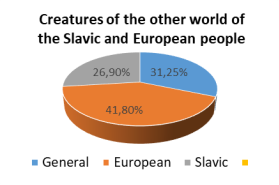
Fig. 2
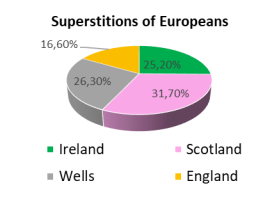
Fig. 3
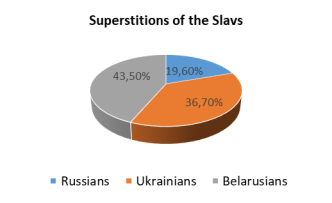
Fig. 4
The Slavs have Belarusians in first place, Ukrainians in second and Russians in third place.
In conclusion, it must be said that we have colled the main evil spirits of our ancestors. After all, there are still small nations with their own culture, and it is impossible to embrace the immensity.
Thus, the hypothesis that the peoples professing Orthodoxy and Catholicism have much in common was confirmed.
In every nation and its traditions, in every religion there are a lot of differences and similarities. But we are all called to love each other, and hatred should not be inherent in us at all. We must be able to build good neighborly relations with everyone, regardless of religion and nation. However, this does not mean that we should not study the contradictions in our cultures. Moreover, every Christian, in our opinion, should clearly understand why he is Orthodox or Catholic and what is the essence and difference of his faith from others.
References:
- Guili R. E. Encyclopedia of ghosts and spirits: [Translation] / Rosemary Ellen Guili. — M.: Veche: Alexander Korzhenevsky, 1997. — 654 p.
- Catholic Encyclopedia: v. 1: A — Z. — M.: «Franciscan Publishing House», 2002. — 1010 p.,
- Ternopol T. V. Slavic demonology: who is the boss in the house, or An Englishman's home is his castle // Questions of Psycholinguistics. — M., 2006 — S. 137–144.
- Ternopol T. V. House Spirits in Ethnographic and Mental Aspects: A Comparative Study of Russian and English Folklore: Abstract of the thesis. dis.... cand. cultural studies: 24.00.01 / Yaroslav. state ped. un-t im. K. D. Ushinsky. — Yaroslavl, 2007. — 22 p.; The same [Electronic resource]. — URL: http://inf.yspu.yar.ru/documents-open/dis/226/ (11.09.22)
- Chumakova T. Orthodoxy. — St. Petersburg: Peter, 2006. — 208 p.
- Shpilevsky P. M. Belarus among Abradah and Cossacks / Per. from Russian A. Vashchanki. Mn.: Literature and Mastatsva, 2010. 304 p.
- Yablokov I. N. Religious Studies: Textbook. — M.: Gyardariki, 2004. — 317 p.






